Arsenal of Japanese samurai (first part)
Let's start by comparing the arsenal of Japanese samurai with the arsenal of a medieval knight from Western Europe. The difference in the quantity and quality of their samples will immediately be evident. Arsenal samurai first of all will be much richer. In addition, many types of weapons will be virtually incomparable with European ones. In addition, what we consider to be truth is in fact very often just another myth. For example, everyone said that the sword is a “samurai soul” because they wrote about it more than once. However, was he their main weapon, and if “yes”, was it always like that? Here is a knight's sword - yes, indeed, the symbol of chivalry was always, but with a samurai sword everything is far from being so unequivocal.
Firstly, it is not a sword, but a saber. We just traditionally call the samurai blade a sword. And secondly, he was far from always his main weapon! And here it is best to remember ... the legendary musketeers of Alexander Dumas! They were called so because their main weapon was a heavy wick musket. However, the heroes of the novel use it except during the defense of the bastion of Saint-Gervais. In the remaining chapters of the novel, they are costing swords. This is understandable. After all, it was the sword, and then its lite version - the sword, which in Europe were symbols of chivalry and belonging to the nobility. Moreover, even a peasant could wear a sword in Europe. Bought - and wear! But in order to own it, it was necessary to study for a long time! And only noblemen could afford it, but not peasants. But the musketeers did not fight with swords, and the situation with the Japanese samurai was exactly the same. The sword among them became especially popular in the years ... of the world, that is, in the Edo era, after 1600, when it turned from a military weapon into a symbol of the samurai class. There was no one to fight the samurai, work was below their dignity, so they took up the fact that they began to sharpen their fencing art, to open fencing schools - in one word to cultivate the art of antiquity and to promote it in every way. In real combat, samurai, of course, also used swords, but at first they did it only as a last resort, and before that they used a bow!
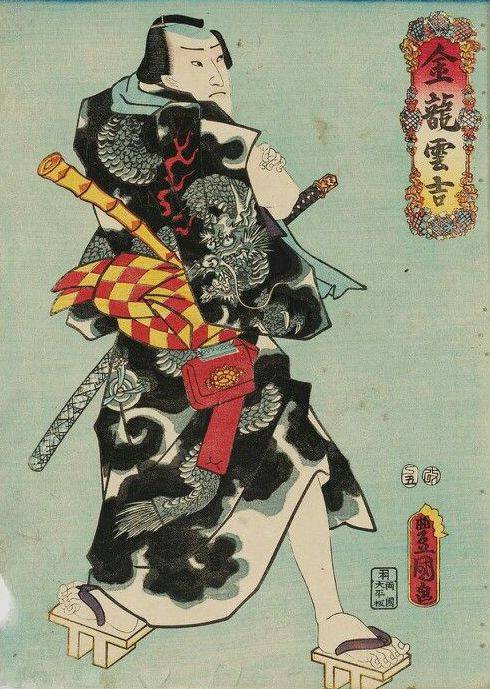
Like the French nobility, samurai did not part with their swords in the days of peace and in the days of war, and even looked at them with an oblique glance as an insult! Woodcut Utagawa Kunisada (1786 - 1865).
In ancient Japanese poems it was said: “Bow and arrows! Only they are the happiness of the whole country a stronghold! ”And these lines clearly show how important it was for the Japanese to be kyudo - the art of archery. Only a notable warrior in ancient Japan could become an archer. His name was yumi-tory - “bow holder”. The bow - yumi and the arrow I - were Japanese sacred weapons, and the expression "yumiya-no miti" ("the path of the bow and arrow") was synonymous with the word "bushido" and meant the same thing - "the path of the samurai." Even the purely peaceful expression "samurai family" and then literally when translating it from Japanese means "family of bows and arrows", and the Chinese in their chronicles called the Japanese "Big bow".
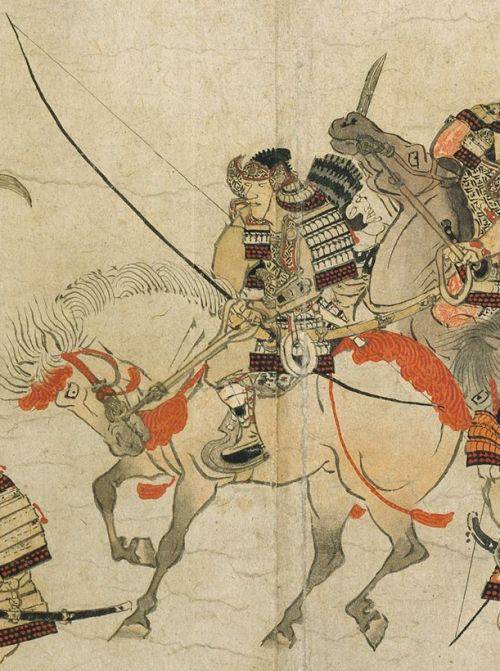
A fragment of the scroll "Heiji no Ran" depicts a rider in a white o-war, armed with a bow and a sword. Scroll created at the beginning of the XIV century.
In “Heike Monogatari” (“The Tale of Heike”), the famous Japanese military chronicles of the XIV century, for example, it is reported as in the 1185 year, during the battle of Yashima, the commander Minamoto-no Kuro Yoshitsune (1159 - 1189) fought desperately to return the bow, which he accidentally dropped into the water. The warriors of the enemy tried to knock him out of the saddle, his own warriors begged to forget about such trifles, but he fearlessly fought with the first, and did not pay attention to the second. He took out the bow, but his veterans began to openly resent such recklessness: “It was terrible, sir. Your bow can cost a thousand, ten thousand gold, but is it worth it to put your life at risk? ”
To which Yoshitsune replied: “The point is not that I did not want to part with my bow. If I had a bow, like the bow of my uncle Tametomo, which only two or even three people could pull, I might even have deliberately left it to the enemy. But my bow is bad. If the enemies found out that it was I who owned them, they would laugh at me: “Look, and this is the bow of the commander Minamoto Kuro Yoshitsune!” I would not want that. Therefore, I risked my life to bring him back. ”
In "Hogan Monogatari" ("The Legend of Hogan Era"), which tells about the military operations of 1156 of the year, Tametomo (1149 - 1170), Uncle Yoshitsune, is said to be an archer so strong that the enemies, taking him prisoner, beat him chisel hands from joints to make it impossible to shoot a bow in the future. The title of "archer" was an honorary title for any distinguished samurai, even when a sword and a spear replaced the bow. For example, commander Imagawa Yoshimoto (1519 - 1560) received the nickname of "The First Archer of the Eastern Sea".
The Japanese made their bows from bamboo, while the difference from the bows of other nations, who also used bamboo for this, was very large and at the same time asymmetric, as it was considered that it would be more convenient for the warrior to aim and shoot. And such a bow was especially convenient for shooting from a horse. Yumi is usually longer than the English “long bows”, as it often reaches the 2,5 meter of length. There are cases that were bows and even longer. So, at the legendary archer Minamoto (1139 - 1170) the bow had a length of 280, see. Sometimes the bows were made so strong that they couldn’t be pulled by one person. For example, Yumi, destined for sea battles, had to pull seven people at once. Modern Japanese onions, as in ancient times, are made of bamboo, various wood and rattan fibers. The usual distance of the aimed shot is 60 meters, well, in the hands of the master, such a weapon can send an arrow to 120 meters. On some bows (at one of the ends), the Japanese reinforced the tips, as if at spears, which allowed this type of weapon, which was called yumi-yari ("bow-spear"), to combine the functions of a bow and spear.
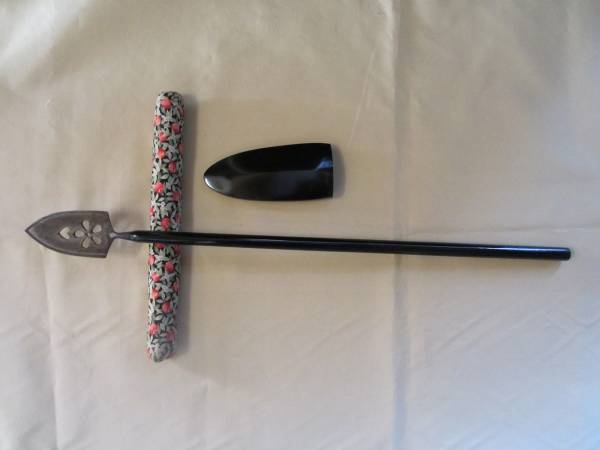
Generic boom and case for her.
Arrow shafts were made from polished bamboo or willow, and plumage - from feathers. The tip of the yadziri was often a true work of art. Special blacksmiths made them, and they often signed their tips. Their forms could be different, for example, forked moon-shaped tips were very popular. Each samurai in his quiver had a special “patrimonial arrow” on which his name was written. According to her, the one killed on the battlefield was recognized in the same way as in Europe it was done by the coat of arms on the shield, and the winner took it as a trophy. Tsuru - bow string - was made from plant fibers and waxed. Each archer had with him also a spare string - a gen, which was placed in a quiver or wound on a special ring-coil tsurumaki, which hung on a belt.
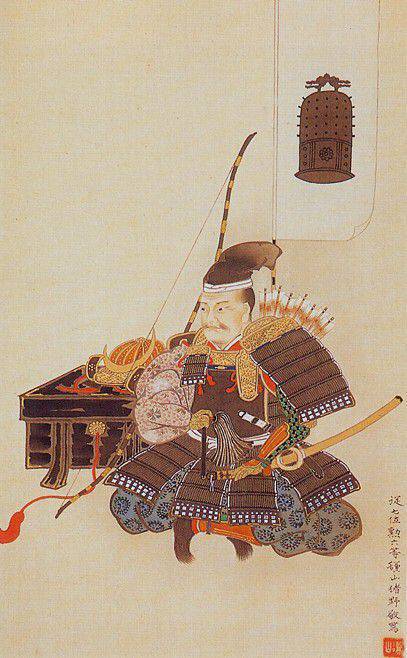
Katakura Kadethune is a samurai in black armor with an ёroy and with the same black bow with a characteristic braid. On the belt reel for spare bowstrings. The back flag of Sasimono depicts a Buddhist bell. City Museum Sendai.
Much kyudo, according to European concepts, lies beyond the framework of a rational understanding of reality and is inaccessible to a person with a western mentality. For example, it is still believed that the shooter in this half-mystical art plays only the role of an intermediary, and the shot itself is carried out, as it were, without its direct participation. At the same time, the shot itself was divided into four stages: greeting, preparation for aiming, aiming and launching an arrow (the latter could be made while standing, sitting, from the knee). A samurai could shoot, even sitting astride a horse, and not from a stationary position, but at full gallop, like the ancient Scythians, the Mongols and the North American Indians!
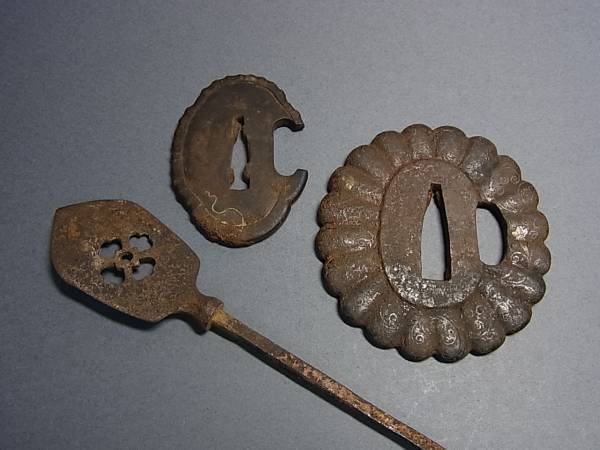
Tribal arrow (left) and two guards tsuba right.
According to the rules, a bushy warrior received an arrow and a bow from his squire, got up from his place and, taking the appropriate posture, demonstrating his dignity and complete self-control. At the same time, it was necessary to breathe in a certain way than to achieve “peace of mind and body” (dojikuri) and readiness for a shot (jugumae). Then the shooter became to the target with his left shoulder, with a bow in his left hand. The legs were supposed to be placed on the length of the arrow, after which the arrow was put on the string and held it with your fingers. Meanwhile, relaxing the muscles in his arms and chest, the samurai raised his bow over his head, and stretched the string. Breathing at that moment needed a stomach, which allowed the muscles to relax. Then he made the shot himself - hanare. The samurai had to concentrate all his physical and mental strength on the “great goal”, striving for the same goal - to unite with the deity, but not at all on the desire to hit the target and not on the target itself. Having made a shot, the shooter then lowered the bow and calmly walked to his place.
Over time, Yumi turned from a weapon of a noble rider into a weapon of a simple infantryman, but even then he did not lose respect for himself. Even the appearance of firearms did not diminish its value, since the bow was faster and more reliable than the primitive arquebus charging from the barrel. The Japanese knew crossbows, including Chinese, multi-charge doku, but they did not receive much distribution in their country.
By the way, horses and riders were specially trained in the ability to cross the river with a rapid flow, and they also had to shoot a bow! Therefore, the onions were varnished (usually black) and also stained. Short bows, similar to Mongolian, were also well-known to the Japanese, and they used them, but it was difficult because the Buddhists in Japan were disgusted with things like the hooves, veins and horns of dead animals and could not touch them, and without this they could make a short but rather powerful bow is simply impossible.
But in Western Europe, the feudal lords did not recognize bow for military weapons. Already the ancient Greeks considered the bow a weapon of a coward, and the Romans called it "insidious and childish." Charlemagne demanded that his warriors wear a bow, issued appropriate capitularies (decrees), but did not succeed much in this! Sports equipment for training muscles - yes, a hunting weapon - to get food in the forest, combining a pleasant time with a useful thing - yes, but fight with a bow in his hands against other knights like himself - yes God forbid! Moreover, bows and crossbows were used in European armies, but ... they recruited commoners for this: in England, the yeoman peasants, in France, the Genoese crossbowmen, and in Byzantium and the Crusader states in Palestine, Turkopule Muslims. That is, in Europe, the main weapon of the knight was originally a double-edged sword, and the bow was considered an unworthy weapon of a noble warrior. Moreover, archer riders in the European armies were forbidden to shoot from a horse. From a noble animal, which was considered a horse, it was necessary to first go, and only after that, take up the bow! In Japan, on the contrary, it was the bow from the very beginning that was the weapon of noble warriors, and the sword served for self-defense in close combat. And only when the wars in Japan stopped, and archery by and large lost all meaning, the sword in the first place in the samurai’s arsenal, in essence, had become by this time an analogue of the European sword. Of course, not by his combat characteristics, but by the role he played in the then Japanese society.
And with the spears it was about the same! Why does a warrior need a spear when a powerful and long-range bow is at his service ?! But when spears in Japan became a popular weapon, their types became so numerous that it is simply amazing. Although, unlike Western knights who used spears from the very beginning of their storiesIn Japan, they received only in the middle of the XIV century, when the infantry began to use them against samurai horsemen.

Senzaki Yagoro Noriyasu is one of 47's loyal ronin, running with a spear in his hand. Woodcut Utagawa Kuniyoshi (1798 - 1861)
The length of the Japanese infantry's javelin jari could be from 1,5 to 6,5 m. Usually it was a spear with a double-edged tip ho, however, spears are known even with several points, with hooks and moonlike blades attached to the tip and diverted from it to the side.
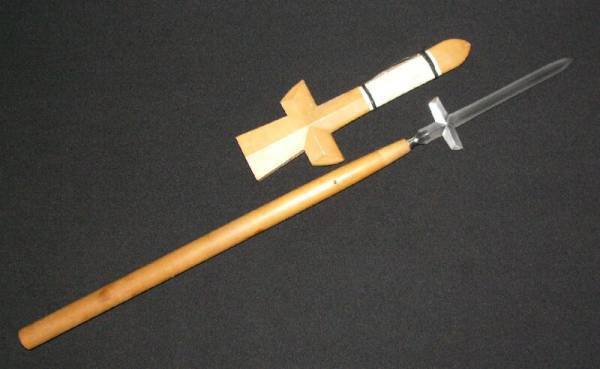
The rarest spear of Kuradasi Jari, the blacksmith Mumei. Edo Era, roughly 1670 g. Next to it is a case of the corresponding form.
Using the spear of Yari, the samurai struck a blow with his right hand, trying to pierce the enemy's armor, and with the left simply held his shaft. Therefore, it was always varnished, and the smooth surface made it easy to rotate in the palms. Then, when the long yari appeared, which became a weapon against the cavalry, they began to be used more as a strike weapon. These spears were usually armed with foot soldiers of ashigaru, resembling an ancient Macedonian phalanx with long peaks lined up one to one.
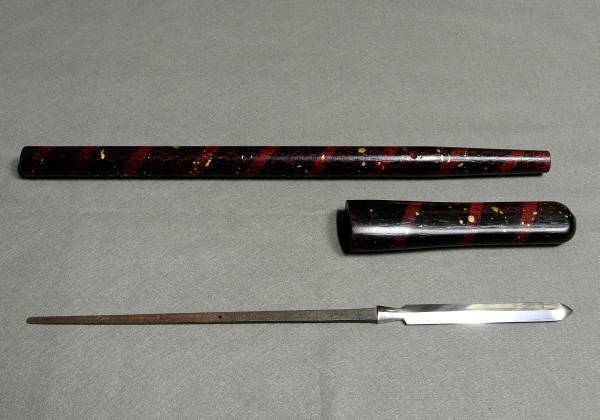
The tip of the spear Yari and case for him.
[Center]
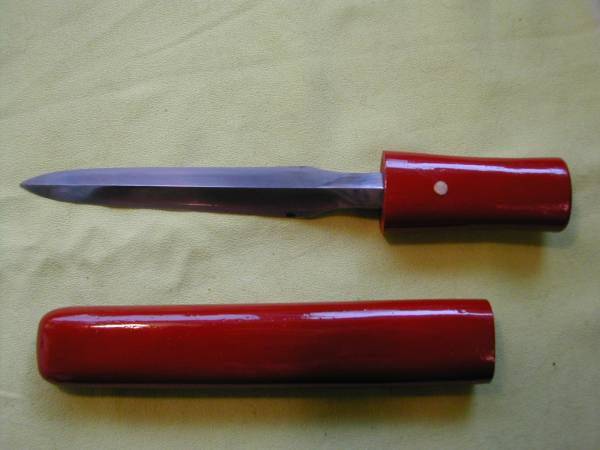
Well, if the spear-head broke, it was not thrown away, but was turned into such an elegant dagger tanto-yari.
Forms of tips differed, as well as their length, of which the longest reached 1 m. In the middle of the Sengoku period, the yar trek was lengthened to 4 m, but it was more convenient for the riders to be controlled by spears with short shafts, and the longest jar remained the guns of the ashigaru infantrymen. Another interesting type of weapons-type weapon forks was sasumat sodze garam or foomata-yari with a metal tip like a slingshot, sharpened from the inside. She was often used by samurai policemen to detain intruders armed with a sword.
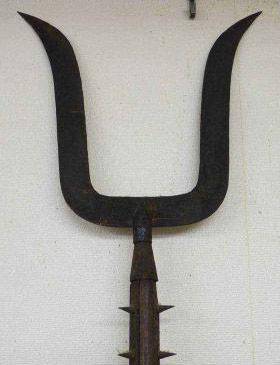
Sasumata Sodze Garama
Invented in Japan and something like a garden trident ripper and called kumade ("bear's paw"). On his images one can often see a chain wrapped around a pole, which must be attached to the wrist or to the armor, so that it is not lost in battle. This gun wonder was used in the storming of locks, during boarding, but in a field battle with its help it was possible to hook the enemy warrior by the horns-kuvagata on the helmet or on the cords on the armor and pull it off the horse or wall. Another variant of the “bear paw” was a club with wide open fingers, entirely made of metal!
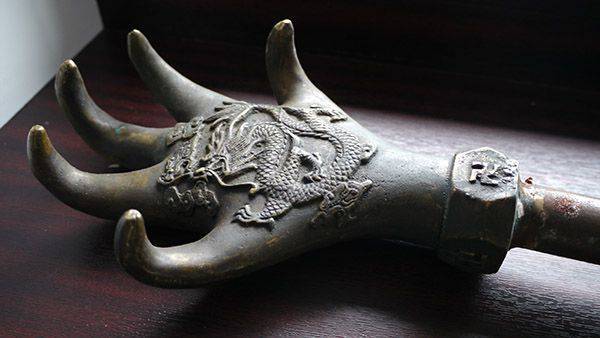
Mace coumade is a bright fusion of two styles of Chinese and Japanese island weapons.
The police also used sode-garami (“tangled sleeve”), a weapon with hooks extending to the sides of the pole, with which they hooked onto the sleeves of the criminal so that he could not use his weapon. The way to work with him is simple to genius. It is enough to get close to the enemy and poke him with a tip with sode-garas (it doesn't matter if he is injured or not!), So that his hooks with the ends bent like fishing hooks stick his body.
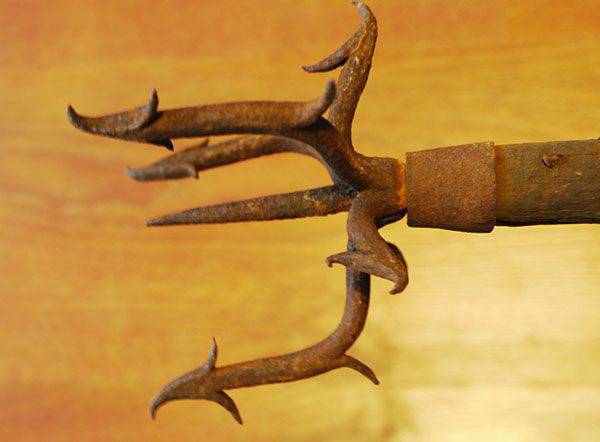
Tip sode-garami.
It was precisely in this way that the murderers, robbers and riotous revelers were captured in the time of Edo. Well, in battle, they tried to hook the enemy with lacing on their armor and pull them off the horse to the ground. So the presence of a large number of cords on Japanese armor was a double-edged sword. In certain cases, for their owner it was simply deadly! On the navy they also used something similar to him - the uti-kagi boarding hook.
Figure A. Shepsa. The author expresses gratitude to the company "Antiques Japan" for the materials provided.
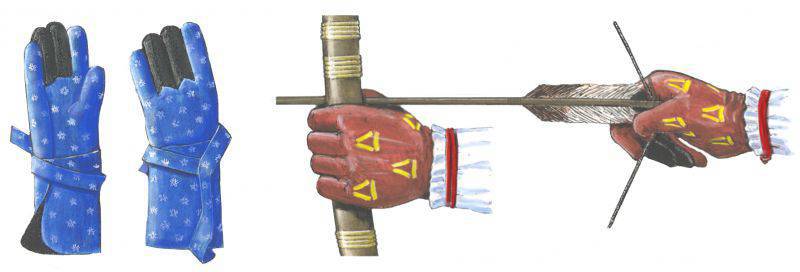
Information